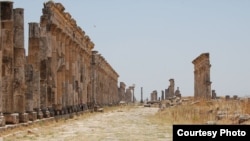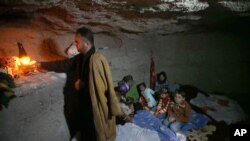The civil war in Syria has resulted in the deaths of more than 90,000 people and forced an estimated three million to flee their homes. Now, experts fear the fighting also is destroying cultural artifacts and archeological sites on an unprecedented scale.
With limited access because of the fighting, archaeologists and experts on Syrian culture try to monitor thousands of important sites representing between 5,000 to 6,000 years of civilization.
Just this past week, Irina Bokova, the UNESCO director-general, noted that the destruction had been especially devastating in and around the northern city of Aleppo.
“After the damages on the Citadel and the burning of the souks, and previous damage to the Great Mosque last October, it has been reported that considerable destruction has taken place at the Mosque on Thursday 28 February,” Bokova said, adding that it had turned “this place of peace and study, one of the most beautiful mosques of all Islamic culture, into a devastated battlefield, notably its museum and library of manuscripts.”
At a conference on U.S. aid for Syria last week, the political opposition’s chairman, Moaz Al-Khatib, said that as the civil war rages on, “…our great cities, historical cities, are being destroyed, and whoever launches a stone against Syria is like launching a stone against one’s own mother, because we are the cradle of civilization.”
A cradle rocked by war
In the chaos of the current fighting, about two million Syrians driven from their homes are reported living among archeological ruins called the Dead Cities.
“One the saddest things is that you have families who have moved back into the caves, the tombs and the underground temples” said Emma Cunliffe, an archeologist at the University of Durham in England.
Before the civil war started, Cunliffe was able to survey many of the nation’s cultural treasures on site. Now she does her research on You Tube and the Internet. She recently learned that families have sought refuge in Serjilla and several other ancient settlements abandoned sometime after the fifth century A.D.
The Associated Press recently reported similar efforts by other Syrians to escape the snipers and daily bombing of the villages of Jirjana and Jebel Al-Zaweya in the hills near Idlib. To avoid large-scale killings last December, dozens of residents began hiding in Roman tombs and other ruins.
Threatened heritage sites in Syria
Serjilla is one of the best-preserved of more than 600 villages in northern Syria known as the Dead Cities. Forty villages have been designated as an archeological park. The recently re-occupied houses are one- and two-story stone structures, mostly without window coverings or roofs. “But it’s best that they can get in from the snowy windswept hillsides,” Cunliffe said.
The Dead Cities are one of six World Heritage Sites in Syria designated by UNESCO. Two other sites mark the meeting of East and West: the ruins of the Roman city of Palmyra, where until a few months ago you could walk between two rows of majestic columns on a major avenue; and the Crac des Chevaliers, headquarters for Richard the Lion-hearted, and the Qal’at Salah El-Din, a chapel converted to a mosque in 1217.
“The Crac is the finest example of medieval castle architecture anywhere in the world,” said Christian Sahner, a scholar at Princeton University. “And it just hapopens that it’s sitting on a hill overlooking the plain of Homs, not in the Loire Valley in France, or in Italy.”
And the Great Mosque of Umayyad in Damascus - an early church and one of Islam’s oldest places of worship - once contained the head of John the Baptist and now contains the tomb of Saladin, the defender of Islam during the crusades.
In terms of the sites important to religions, few countries can match Syria. Cunliffe lists the landmarks: Before the latest fighting, Christians traveling on the road to Damascus could visit the church where Paul stayed after his conversion. Muslims could worship in a mosque in Homs where companions of the Prophet Mohammed stayed. And Jews could climb the hill overlooking Aleppo where Abraham once tended his sheep.
Alexander the Great’s Macedonian lieutenants built vast cities in Palmyra and Apamea. Roman ruins dot the Syrian landscape.
Three more UNESCO heritage sites are the entire cities of Damascus, Aleppo and Bosra. Bosra is now a small town of several thousand residents, many living in the extensive ruins of a major Roman trading center first mentioned in the letters of an Egyptian pharaoh in the 14th century BC.
War threatens Syria’s past
A Syrian government official denies that looting has occurred in the government’s 36 major museums, but theft from remote sites is of great concern. The head of Syria’s antiquities directorate, Maamoun Abdulkarim, told the Jordan Times looters are digging for artifacts in broad daylight.
Sahner, who spent parts of two years in Syria before the war, reported in the Wall Street Journal that looting has occurred across Palmyra’s Valley of Tombs and other ruins scattered across a desert oasis. He said Syrian army tanks recently occupied Apamea’s colonnaded street and shelled the 12th-century fortress of Qala'at al-Mudiq, which stands atop the old Roman acropolis.
But academic researchers caution that verifying claims of destruction during a war is often difficult.
“Some of these reports may have been forged for propaganda purposes,” Cunliffe adds. When the Vatican protested following reports of a fire in the Syrian-Catholic diocese offices in Aleppo, photographs later proved the report false.
But the international police organization, Interpol, reports there is solid evidence that looted Syrian artifacts are moving through a thriving network of black market dealers operating much as they did selling artifacts from Afghanistan and Iraq. Interpol has begun posting descriptions of looted Syrian mosaics on the Internet.
Some of the artifacts apparently are being put on sale by Syrian rebels.
“Some days we are fighters. Others we are archeologists,” 27-year-old rebel Jihad Abu Saoud from Idlib told the Jordan Times. Saoud acknowledges he had uncovered Bronze Age tablets containing Sumerian script.
“The rebels need weapons, and antiquities are an easy way to buy them,” one buyer told the newspaper.
With limited access because of the fighting, archaeologists and experts on Syrian culture try to monitor thousands of important sites representing between 5,000 to 6,000 years of civilization.
Just this past week, Irina Bokova, the UNESCO director-general, noted that the destruction had been especially devastating in and around the northern city of Aleppo.
“After the damages on the Citadel and the burning of the souks, and previous damage to the Great Mosque last October, it has been reported that considerable destruction has taken place at the Mosque on Thursday 28 February,” Bokova said, adding that it had turned “this place of peace and study, one of the most beautiful mosques of all Islamic culture, into a devastated battlefield, notably its museum and library of manuscripts.”
... whoever launches a stone against Syria is like launching a stone against one’s own mother, because we are the cradle of civilizationMoaz Al-Khatib, Syrian opposition leader
A cradle rocked by war
In the chaos of the current fighting, about two million Syrians driven from their homes are reported living among archeological ruins called the Dead Cities.
“One the saddest things is that you have families who have moved back into the caves, the tombs and the underground temples” said Emma Cunliffe, an archeologist at the University of Durham in England.
Before the civil war started, Cunliffe was able to survey many of the nation’s cultural treasures on site. Now she does her research on You Tube and the Internet. She recently learned that families have sought refuge in Serjilla and several other ancient settlements abandoned sometime after the fifth century A.D.
The Associated Press recently reported similar efforts by other Syrians to escape the snipers and daily bombing of the villages of Jirjana and Jebel Al-Zaweya in the hills near Idlib. To avoid large-scale killings last December, dozens of residents began hiding in Roman tombs and other ruins.
Threatened heritage sites in Syria
Serjilla is one of the best-preserved of more than 600 villages in northern Syria known as the Dead Cities. Forty villages have been designated as an archeological park. The recently re-occupied houses are one- and two-story stone structures, mostly without window coverings or roofs. “But it’s best that they can get in from the snowy windswept hillsides,” Cunliffe said.
The Crac is the finest example of medieval castle architecture anywhere in the worldSyria scholar Christian Sahner
“The Crac is the finest example of medieval castle architecture anywhere in the world,” said Christian Sahner, a scholar at Princeton University. “And it just hapopens that it’s sitting on a hill overlooking the plain of Homs, not in the Loire Valley in France, or in Italy.”
And the Great Mosque of Umayyad in Damascus - an early church and one of Islam’s oldest places of worship - once contained the head of John the Baptist and now contains the tomb of Saladin, the defender of Islam during the crusades.
In terms of the sites important to religions, few countries can match Syria. Cunliffe lists the landmarks: Before the latest fighting, Christians traveling on the road to Damascus could visit the church where Paul stayed after his conversion. Muslims could worship in a mosque in Homs where companions of the Prophet Mohammed stayed. And Jews could climb the hill overlooking Aleppo where Abraham once tended his sheep.
Alexander the Great’s Macedonian lieutenants built vast cities in Palmyra and Apamea. Roman ruins dot the Syrian landscape.
Three more UNESCO heritage sites are the entire cities of Damascus, Aleppo and Bosra. Bosra is now a small town of several thousand residents, many living in the extensive ruins of a major Roman trading center first mentioned in the letters of an Egyptian pharaoh in the 14th century BC.
War threatens Syria’s past
A Syrian government official denies that looting has occurred in the government’s 36 major museums, but theft from remote sites is of great concern. The head of Syria’s antiquities directorate, Maamoun Abdulkarim, told the Jordan Times looters are digging for artifacts in broad daylight.
Sahner, who spent parts of two years in Syria before the war, reported in the Wall Street Journal that looting has occurred across Palmyra’s Valley of Tombs and other ruins scattered across a desert oasis. He said Syrian army tanks recently occupied Apamea’s colonnaded street and shelled the 12th-century fortress of Qala'at al-Mudiq, which stands atop the old Roman acropolis.
The rebels need weapons, and antiquities are an easy way to buy theman antiqities buyer in Jordan
“Some of these reports may have been forged for propaganda purposes,” Cunliffe adds. When the Vatican protested following reports of a fire in the Syrian-Catholic diocese offices in Aleppo, photographs later proved the report false.
But the international police organization, Interpol, reports there is solid evidence that looted Syrian artifacts are moving through a thriving network of black market dealers operating much as they did selling artifacts from Afghanistan and Iraq. Interpol has begun posting descriptions of looted Syrian mosaics on the Internet.
Some of the artifacts apparently are being put on sale by Syrian rebels.
“Some days we are fighters. Others we are archeologists,” 27-year-old rebel Jihad Abu Saoud from Idlib told the Jordan Times. Saoud acknowledges he had uncovered Bronze Age tablets containing Sumerian script.
“The rebels need weapons, and antiquities are an easy way to buy them,” one buyer told the newspaper.









